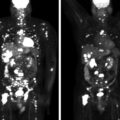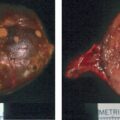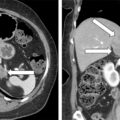Endocrinologists have a “love-hate relationship” with the measurement of dehydroepiandrosterone sulfate (DHEA-S). Measurement of serum DHEA-S concentration is very useful when it is either very low or very high in a patient with an adrenal mass. When the serum DHEA-S is suppressed in a patient with an adrenal mass, it suggests chronic suppression of pituitary corticotropin (ACTH) secretion: a finding consistent with either subclinical glucocorticoid secretory autonomy or adrenal-dependent Cushing syndrome. On the other hand, when the serum DHEA-S concentration is high in a patient with an adrenal mass, it is suggestive of an androgen-secreting adrenal tumor and frequently adrenocortical carcinoma; again, it is a useful biomarker in this setting. However, in the United States the most common reason clinicians measure serum DHEA-S is for a premenopausal woman with hirsutism—the serum DHEA-S concentration is frequently mildly to moderately elevated above the upper limit of the reference range. An elevated serum DHEA-S concentration in a premenopausal woman frequently leads to imaging studies of the adrenal glands and ovaries because of the concern about a neoplastic source—something only rarely found. Herein we share one approach to the clinical conundrum of increased serum DHEA-S concentrations in premenopausal women.
Case Report
The patient was a 25-year-old woman who had progressively increasing facial hair over the past 10 years. She had tried laser therapy but found the effects not optimal. Menarche was at age 11 years, and her menstrual cycles had always been irregular. She had acne in her teenage years, but much less so now. She had no temporal scalp hair recession or increased hair on her breasts, abdomen, and back. She had no change in libido. Three months before referral, serum concentrations of DHEA-S and total testosterone were measured and found to be elevated at 565 mcg/dL (normal, 83–377 mcg/dL) and 76 ng/dL (normal, 8–60 ng/dL), respectively. The elevated DHEA-S was further evaluated with computed tomography (CT) scan of the abdomen (which showed normal-appearing adrenal glands) and transvaginal ovarian ultrasound (which showed normal sized ovaries with several cysts present). She was moderately overweight but had no recent weight gain. She had no signs or symptoms of Cushing syndrome. There was no history of hypertension or hypokalemia. She was taking no regular medications. On physical examination, her body mass index was 32.7 kg/m 2 , blood pressure 118/76 mmHg, and heart rate 84 beats per minute. She had marked hirsutism on her chin and cheeks. The degree of hirsutism elsewhere was minimal to mild. Her Ferriman-Gallwey score was 11 (normal, <8; maximum = 36). She had no signs of scalp hair loss. External genitalia examination showed a normal appearing clitoris. There were no signs of glucocorticoid excess.
INVESTIGATIONS
Laboratory test results are shown in Table 88.1 . The serum DHEA-S concentration remained elevated at 526 mcg/dL (normal, 83–377 mcg/dL). There was minimal elevation in serum testosterone. To determine if the source of DHEA-S hypersecretion was neoplastic, we completed a 7-day dexamethasone suppression test (DST): dexamethasone 0.5 mg at bedtime daily for 7 days and on the morning of day 8 serum DHEA-S was measured. With the 7-day DST, the serum DHEA-S concentration normalized to 103 mg/dL.
| Biochemical Test | Result | Reference Range |
| Sodium, mEq/L Potassium, mEq/L Creatinine, mg/dL Total testosterone, ng/dL Bioavailable testosterone, ng/dL DHEA-S, mcg/dL Androstenedione, ng/dL LH, IU/L FSH, IU/L 8 am serum ACTH, pg/mL 8 am serum cortisol, mcg/dL 4 PM serum cortisol, mcg/dL Midnight salivary cortisol, ng/dL 24-Hour urine: Cortisol, mcg | 140 4.2 0.8 72 3.8 605 122 9.0 5.2 20 14 7.2 <50 18 | 135–145 3.6–5.2 0.6–1.1 8–60 0.8–4.0 83–377 30–200 1.9–14.6 a 2.9–14.6 a 10–60 7–25 2–14 <100 3.5–45 |
Stay updated, free articles. Join our Telegram channel

Full access? Get Clinical Tree








